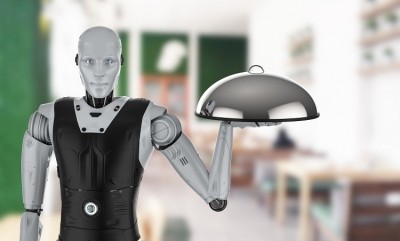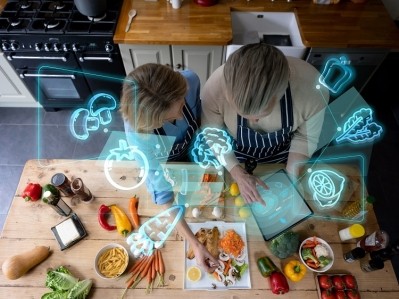Five years from now, how will AI have changed the food industry?

Artificial intelligence is influencing all industries, everywhere. And as AI-enabled technologies evolve and adoption increases, so too will its impact.
In food, where AI is already infiltrating a host of different processes, the technology shows no sign of slowing down. Gazing into the crystal ball, it’s predicted that AI, machine learning, and next-gen algorithms will continue to disrupt.
Fast-forward five years from now, how will AI have changed the food industry?
AI will take over mundane tasks in the food industry
“I want AI to do my laundry and dishes so that I can do art and writing, not for AI to do my art and writing so that I can do my laundry and dishes,” wrote future-thinking author Joanna Maciejewska recently.
It’s obvious to anyone using large language models such as ChatGPT or Midjourney, as well as those doing the laundry and dishes, that AI is better suited to creative pursuits than domestic duties.
Has industry got it wrong? Well, perhaps. But not for long. Looking to the future, it’s the mundane tasks that AI will be best-suited to take on, according to Olaf van der Veen, founder and CEO of AI-powered food waste monitoring tech start-up Orbisk.
Artificial intelligence and data sets have the potential to make the entire food system more efficient, more sustainable, and less waste-intensive, he believes. This is particularly relevant in the restaurant sector, where AI can manage ‘mundane’ and ‘repetitive’ tasks for operators, suggested van der Veen at food- and ag-tech conference F&A Next in the Netherlands.
In the case of food waste, it’s unlikely chefs will take the time to monitor exactly where food waste occurs on the premises. When one considers that an average-sized restaurant is through to waste around 30-60kg of food in a day – equating to more than 10,000kg of food per year, per restaurant – that’s not good news for the environment, nor the restaurant’s bottom line.

Orbisk leverages image tracking reignition technology to identify which ingredients are being wasted and in what quantities. And this is just one way that AI can serve as an industry ‘co-pilot’, he explained.
AI-enabled tech can allow for industry players to avoid the mundane and focus on doing what they do best: offer ‘excellent products’ and ‘excellent service’. “That’s what I think AI will do in the food system, whilst providing efficiency, sustainability, and economic [benefits].”
Understanding what consumers want from food and drink
One of the primary challenges facing the food industry is understanding consumer trends. What kinds of foods, flavours, formats, and ingredients do shoppers want to buy?
Traditionally, food and beverage brands have relied on sensory panels, market analysis, and real-world testing to inform new product development. And to a considerable extent, they still do.
But five years from now, AI could completely transform how brands understand what consumers want from food.
This is Alon Chen’s perspective, who heads up Israeli start-up Tastewise. The business leverages AI to analyse restaurant and delivery menus, social media interactions, and at-home recipes online to help food and beverage innovators identify opportunities in the market.
“We’re looking at consumer decisions and extrapolating what their intent will be,” explained the Tastewise co-founder and CEO at F&A Next. “In the next five years, consumer intents and decisions will be visible and fully understandably by industry.”
Chen is baffled that with all the data currently available, including from food delivery platforms, industry still does not know what’s on the consumer’s plate. “There’s so much information out there…
“In five years, it’s going to be extremely clear to all of us what people eat and drink and why.”
Better insights into fruit and vegetable cultivation
Another challenge facing the food industry lies in logistics and quality control. AI-powered tech has the potential to improve both, believes Jonathan Berte, founder of computer vision AI platform Robovision in Belgium.
When working with fresh produce such as tomatoes or bell peppers in open field cultivation, adverse weather events can significantly impact quality and quantity. This has an obvious knock-on effect for retailers, who may suffer supply shortages.
But if a retailer’s AI-powered weather forecasting model identifies an upcoming heatwave, which it knows will negatively impact tomato supply, it could avoid being caught short by increasing its tomato order from greenhouse producers.

Robovision uses deep learning technology to develop agricultural robots for greenhouses, to which it can apply ‘sensory innovations’, explained Berte. This could include robotic ‘grippers’ to harvest fresh produce, or hyperspectral imaging to help identify and combat disease.
In the coming years, the founder expects these kinds of technology will offer industry a much better handle on fresh produce cultivation, which will in turn impact stakeholders further down the supply chain.
“We will know everything about each fruit and vegetable, and that will generate an enormous number of consecutive choices for consumers and retailers alike.”
The food retail sector should be prepared for AI disruption at scale
The food retail sector should prepare itself for a full-scale disruption, powered by AI.
This is the perspective of Sabine Benoit, professor of marketing at the UK’s University of Surrey, who believes AI-enabled technology will completely reshape how consumers shop.
AI-enabled technology won’t replace food stores, but food stores with AI-enabled technology will replace food stores without it, she told delegates at IFE in London.

AI-powered in-store navigation, for example, can offer a Google Maps-style tool to shoppers. When a consumer searches for a particular food product on their phones, they could be led to the item, and alerted to its location by a blinking digitised price tag.
For those suffering with food allergies, AI technology could be leveraged to scan barcodes and inform consumers if the product in question is unsafe to consume. And image-recognition scales for fresh produce could mean that scales not only detect the weight of the fruit or vegetable, but also the specific variety.
In retail, AI disruption is not targeting the shopper only; how employees interact with shoppers in-store will also likely change. In larger retail stores, employees often use headsets to communicate with each other – these are what Benoit describes as ‘first generation’ headsets.
In the future, it could be that these headsets enter the ‘second generation’ phase. By linking up to ChatGPT, employee headset could automatically respond to staff member or customer queries.
How else is AI predicted to disrupt food retail?
Find out here: Seven ways artificial intelligence is shaking up food retail
Artificial intelligence is unlocking innovation in the retail sector, powering everything from smart trolleys to facial recognition checkouts.















